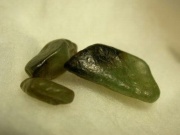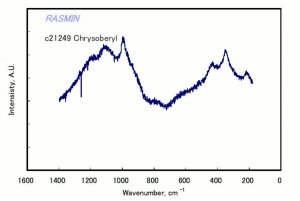Difference between revisions of "Chrysoberyl"
m (Text replace - "== Authority ==" to "== Sources Checked for Data in Record ==") |
|||
| Line 10: | Line 10: | ||
[[[SliderGallery rightalign|chrysoberylRS.jpg~Raman]]] | [[[SliderGallery rightalign|chrysoberylRS.jpg~Raman]]] | ||
| − | == | + | ==Physical and Chemical Properties== |
| − | Orthorhombic crystal system. Good cleavage in one direction. | + | * Orthorhombic crystal system. |
| − | + | * Good cleavage in one direction. | |
| − | Fracture = uneven to conchoidal. Luster = vitreous. Streak = colorless to white. Alexandrite is | + | * Fracture = uneven to conchoidal. |
| + | * Luster = vitreous. | ||
| + | * Streak = colorless to white. | ||
| + | * Alexandrite is strongly pleochroic. | ||
{| class="wikitable" | {| class="wikitable" | ||
| Line 25: | Line 28: | ||
|- | |- | ||
! scope="row"| Density | ! scope="row"| Density | ||
| − | | 3.5-3.8 | + | | 3.5-3.8 g/ml |
|- | |- | ||
! scope="row"| Refractive Index | ! scope="row"| Refractive Index | ||
| 1.745-1.754 | | 1.745-1.754 | ||
|} | |} | ||
| − | |||
| − | |||
| − | |||
| − | |||
== Comparisons == | == Comparisons == | ||
| Line 39: | Line 38: | ||
[[media:download_file_403.pdf|Properties of Gemstones]] | [[media:download_file_403.pdf|Properties of Gemstones]] | ||
| − | + | ==Resources and Citations== | |
| − | + | * Mineralogy Database: [http://www.webmineral.com/data/Chrysoberyl.shtml Chrysoberyl] | |
| − | == | ||
| − | |||
* Jack Odgen, ''Jewellery of the Ancient World'', Rizzoli International Publications Inc., New York City, 1982 | * Jack Odgen, ''Jewellery of the Ancient World'', Rizzoli International Publications Inc., New York City, 1982 | ||
* R.F.Symmes, T.T.Harding, Paul Taylor, ''Rocks, Fossils and Gems'', DK Publishing, Inc., New York City, 1997 | * R.F.Symmes, T.T.Harding, Paul Taylor, ''Rocks, Fossils and Gems'', DK Publishing, Inc., New York City, 1997 | ||
| − | * ''Encyclopedia Britannica'', http://www.britannica.com Comment: "chrysoberyl." | + | * ''Encyclopedia Britannica'', http://www.britannica.com Comment: "chrysoberyl." Accessed 7 Apr. 2005 . |
* C.W.Chesterman, K.E.Lowe, ''Audubon Society Field Guide to North American Rocks and Minerals'', Alfred A. Knopf, New York, 1979 | * C.W.Chesterman, K.E.Lowe, ''Audubon Society Field Guide to North American Rocks and Minerals'', Alfred A. Knopf, New York, 1979 | ||
| − | * Wikipedia | + | * Wikipedia: http://en.wikipedia.org/wiki/Chrysoberyl (Accessed Sept. 2, 2005) |
* G.S.Brady, ''Materials Handbook'', McGraw-Hill Book Co., New York, 1971 Comment: p. 101 | * G.S.Brady, ''Materials Handbook'', McGraw-Hill Book Co., New York, 1971 Comment: p. 101 | ||
Revision as of 14:43, 29 May 2022
Description
A hard green to yellow mineral composed of beryllium aluminate. Chrysoberyl occurs in granitic rocks, pegmatites, and mica schists. Some transparent varieties of chrysoberyl have been used as gemstones. In the 18th century, a large deposit of clear, yellowish-green chrysoberyls was found in Brazil and the stones were popularly used for Portuguese and Spanish jewelry. Cat's eye chrysoberyls are cut as cabochons and polished. The Alexandrite variety of chrysoberyl appears red in artificial light and green in daylight. Chrysoberyls are found in the Ural Mountains (alexandrite), Czech Republic, Sri Lanka, Rhodesia, Brazil, Malagasy Republic and the United States (New York, Colorado).
Synonyms and Related Terms
cat's eye; cymophane; golden beryl; alexandrite; oriental chrysolite; crisoberilo (Esp., Port.); chryzoberyl (Pol.); Chrysoberyll (Deut.); chrysoberyl (Ned.)
Physical and Chemical Properties
- Orthorhombic crystal system.
- Good cleavage in one direction.
- Fracture = uneven to conchoidal.
- Luster = vitreous.
- Streak = colorless to white.
- Alexandrite is strongly pleochroic.
| Composition | BeAl2O4 |
|---|---|
| Mohs Hardness | 8.5 |
| Density | 3.5-3.8 g/ml |
| Refractive Index | 1.745-1.754 |
Comparisons
Resources and Citations
- Mineralogy Database: Chrysoberyl
- Jack Odgen, Jewellery of the Ancient World, Rizzoli International Publications Inc., New York City, 1982
- R.F.Symmes, T.T.Harding, Paul Taylor, Rocks, Fossils and Gems, DK Publishing, Inc., New York City, 1997
- Encyclopedia Britannica, http://www.britannica.com Comment: "chrysoberyl." Accessed 7 Apr. 2005 .
- C.W.Chesterman, K.E.Lowe, Audubon Society Field Guide to North American Rocks and Minerals, Alfred A. Knopf, New York, 1979
- Wikipedia: http://en.wikipedia.org/wiki/Chrysoberyl (Accessed Sept. 2, 2005)
- G.S.Brady, Materials Handbook, McGraw-Hill Book Co., New York, 1971 Comment: p. 101
- Van Nostrand's Scientific Encyclopedia, Douglas M. Considine (ed.), Van Nostrand Reinhold, New York, 1976
- Random House, Webster's Encyclopedic Unabridged Dictionary of the English Language, Grammercy Book, New York, 1997
- The American Heritage Dictionary or Encarta, via Microsoft Bookshelf 98, Microsoft Corp., 1998

